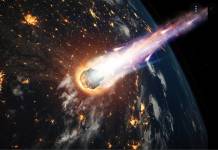
American scientists have found a correlation between the Earth’s rotation speed and the ratio of big earthquakes that occur every year. Our planet has been slowing down, and 2018 might be a year when we have as many as 20 earthquakes magnitude 7 and above.
Researchers Roger Bilham of the University of Colorado and Rebecca Bendick of the University of Montana warned about their findings in a publication on the Geophysical Research Letters journal last August and presented them at the recent annual meeting of the Geological Society of America.
Some in the scientific community remain skeptical, particularly due to the implications such conjectures might have. We still don’t have a way to accurately predict earthquakes, but this might be the first step if Bilham and Bendick prove to be right next year.
Upsurge in big earthquakes predicted for 2018 as Earth rotation slows https://t.co/tgiHiOmqI5
— Guardian Science (@guardianscience) November 18, 2017
Earth is giving us “a five-year heads-up on earthquakes”
According to the new research, major earthquakes on Earth happen around five years after a maximum deceleration event occurs. These are gradual, periodical slowdowns that make the Earth’s rotation slower and lengthen the day by one millisecond.
This might not seem like much, and it is virtually unperceivable by us humans, but put in perspective, we find that today’s days are longer than days in the year 1900 by almost two full seconds. Five year periods precede a slowdown event, which tends to coincide with years in which seismic activity heightens.
Scientists say the average number of big earthquakes is 15 a year. In the years that follow the addition of a millisecond to the Earth’s rotation time, earthquakes of magnitudes larger than 7 exceed 20 around the world, sometimes ramping up to 35 a year.
Scientists are about to test a devastating hypothesis: 2018 will suffer a lot of big earthquakes https://t.co/Z1QDfCcR9I
— David Papp (@DavidPapp) November 19, 2017
The key to earthquake prediction may lie on the Earth’s core
Of course, this is all a theory at this point, and while the correlation has been highlighted, it needs to be proven so it can gain credibility in the scientific community. Many peers of Bilham and Bendick are still expecting them to be proven wrong next year.
The specific cause of intensified seismic activity has yet to be found, but scientists suggest the slowdown in Earth’s rotation could have an effect on the planet’s core and the energy it releases. The trends found by the Montana and Colorado researchers show most earthquakes happen near the Equator.
Tropical countries would be at risk under this assumption, which has divided geologists and common people alike due to what it entails. On one hand, there is the first step towards a model of potential earthquake prediction, at least on a time basis. On the other hand, the death tally would easily be in the thousands if it turns out to be true.
Source: The Guardian











